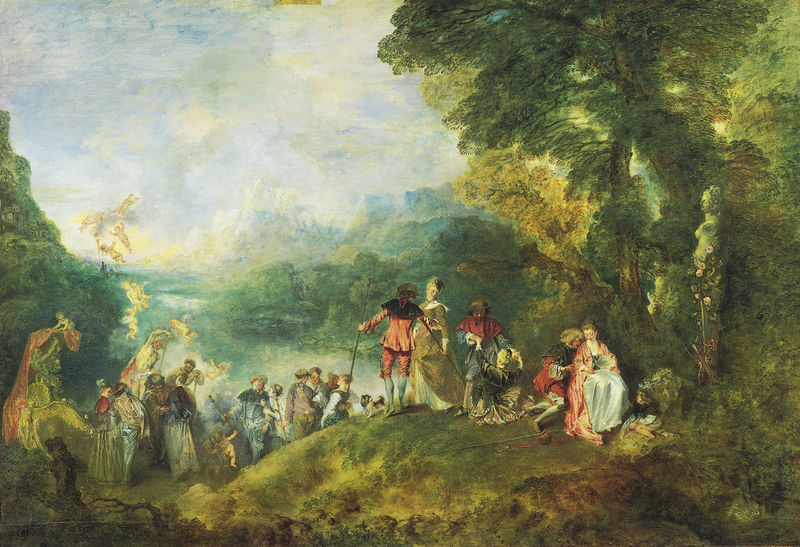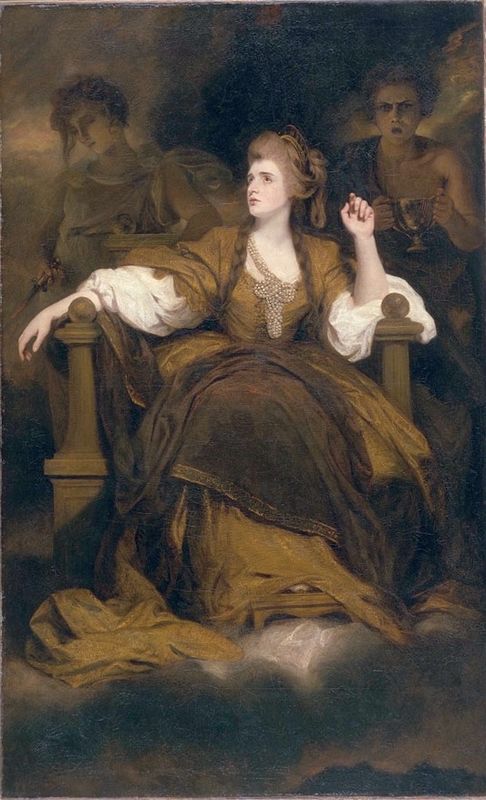French Philosopher Jean-Jacques Rousseau (b.1712 - d. 1778) wrote, "Man is born free, but is everywhere in chains!" Rousseau is often considered to be the god-father of the Romantic Period. The quote above is from his piece, The Social Contract, ca. 1762, and it feels as relevant today as it might have on the eve of the French Revolution. Below, I will look at some Romantic works of art that embody the idea of the war against man's inhumanity to man and the dilemma of "freedom" - is it a state of mind? A state institution? Or, is it just a word?
The Period of Romanticism is a bit of a complicated term, in the sense that it doesn't have much to do with what we now define as "romantic", such as walk a long the beach at sunset, or falling in love. Below is an image from "Romantic" artist Goya. I doubt it would take an Art History genius to deduce, that at the time he painted this work, Goya had something other than frozen yogurt and love on his mind.
This deduction would be pretty spot on. Francisco Goya (b. 1746 - d. 1828) was a Spanish artist who had a chance to experience the glory of the Spanish Monarchy before and during it's downfall, and in 1808, his native country to be violently overthrown by Napoleon, thanks to a traitorous Ferdinand VII and a gullible, Spanish politician, Godoy. In short, Goya had seen the precariousness of the integrity of man and in the drawing and paintings below he shares it with us. Here is where the romance enters... Goya shares with us how he "feels" and how we, if we might feel when we ponder the actions and consequences of powerful men playing dangerous games with humanity. What one ends up feeling ultimately, is that regardless of your station in society, your role in events as a spectator or participant, we are all accountable for our own actions and perhaps more importantly, our in-actions, in the end.
 |
Francisco Goya
The Sleep of Reason Produces Monsters
ca. 1797 - 1799 |
In Goya's sketch above we see an artist (I think Goya himself) exhausted and passed out at his desk. We are witnessing the imminent demise of his subconsciousness, as the unrelenting creatures of the night descend upon his vulnerable form. Why, we must ask ourselves, is this man so vulnerable? Has he lost the privilege of a decent nights sleep and to whom did he lose this privilege, and how? It begs the question, if reason is in jeopardy is not freedom at risk, even and especially, the ultimate freedom, the freedom of the human mind? Goya has drawn one of the night owls with intensely, blazing eyes, whose gaze is focused directly on us the viewer, as if to say, "You think you see before you a doomed man who has placed himself in this torturous predicament, but... you the viewer are not free from the same potential fate". It feels like a warning.
Francisco Goya
Saturn Devouring His Son
ca. 1819 - 1823
In the piece above, Goya tells the story of Saturn, who has been informed of the prophecy that one of his children will depose him. He attempts to prevent this by devouring any children born to him, immediately following their birth. Goya has painted Saturn here in a way that underlines the absurdity in his attempt to remain in control, and as the story goes, one of his sons, Jupiter, manages to escape the gruesome form of patricide and eventually supplants his father. So all the insanity, was eventually for not. Goya's status as an artist gave him a front and centre seat to the drama of the war and destruction that was played out in Spain, in the early nineteenth century. Men desperately trying to maintain power and control over their country and the people in it, and failing. This painting can be read in many ways, but I like to think Goya was making a statement about the futility of war and man's grotesque drive, to divide and conquer his fellow human beings.
 |
Francisco Goya
The Third of May in Madrid 1808:
The Executions on Principio Hill
ca. 1814 |
In the painting above Goya gives us a scene intensely realistic, lacking in the heroism typically promoted in historical and military paintings, up to this point in time. Here, Spanish rebels and freedom fighters are being meticulously executed, not dying the noble death of a martyr, but rather the cold death of real human beings. The expressions on their faces are not of acceptance, having made peace with what is about to come at dying a violent death for a noble cause. The faces of these men are filled with fear and and the knowledge of betrayal. They have been betrayed by their fellow man, and the distinct lack of glory here, is disturbing.
Below is a painting by Eugène Delacroix (b. 1768 - d. 1863) depicting a scene from Byron's play, Sardanapulus. Again, we have a painting that is completely devoid of a hero. Rather than admit defeat and surrender, the Assyrian King decides to take his own life, and everyone and everything he holds dear with him. It is the ultimate scene of narcissistic corruption and destruction. Delacroix shows us a leader who has no regard for anyone or anything other than himself, mirroring the political and social structure in the real world, he seems to be asking the viewer, "Do you believe the men that hold your freedom in their hands, respect you, any more this?" Painted in the wake of the French Revolution, Delacroix reminds us here that corruption is ever present, regardless of who is in power. Did Napoleon not ride to power, glory and ultimate corruption, on the idea of freedom?
 |
Eugène Delacroix
The Death of Sardanapulus
ca. 1827
The painting below is by French artist Théodore Géricault, (b. 1791 - d. 1824). It is a depiction of an actual event that occurred ca. 1815, where the captain of a merchant vessel realized that the ship was going down. There were not enough life-boats for all the people aboard, so the captain had the carpenter crew construct a raft for the 150 people that were not important enough to warrant a seat on a real life-boat. The idea was that the life-boat would tow the raft, but when the captain realized he could make no headway in this manner, he cut the raft and all the people aboard, adrift. Only 15 of the 150 passengers survived. In this painting Gericault reminds the people that the French Revolution had failed, the Monarchy was back in power and corruption was rampant. He does this by choosing a contemporary subject, involving men in power deciding who lives and who dies, asking us the viewers, how do feel about this? In a world where man treats his fellow man with such little regard, can freedom exist? If your neighbour is not free, how can you possibly be free? Perhaps, if there is only some freedom, there is no freedom. |
 |
Théodore Géricault
The Raft of Medusa
ca. 1819
|
The last painting I will look at is by the German artist, Caspar David Friedrich (b. 1774 - d. 1840). We see below a funeral procession, monks in the process of the ritual of burial. As the viewer, we feel the bleak, cold winter, perhaps just before sunset, pressing down on the scene. The monks are passing under what is left of an Abbey, a windowless, crumbling arch, flanked by black, gnarled, leafless oak trees. The moon is in it's cycle, as is everything else in the painting. Life is a cycle. Death is a cycle. The earth and the moon are cycling and we are all a part of it. Although the painting evokes dark and bleak emotions about life, leading ultimately to death, there is hope also, in the lingering light of the setting sun reminding us that spring will come again, too.

The scene is a metaphorical landscape that brings into question not just freedom of the mind and body, but the soul. Friedrich and his contemporaries of the time were showing the public that it was time to start looking at the human role in the world around them in a new way, not simply as those who obey the powers that be, the Church, the Monarchy, the military and history... that a new definition of our role in the world and the universe, must be discussed. The Romantics were recognizing and displaying the fallibility and the frailty of human kind, and in this process, reevaluating and redefining freedom. A process that continues to this day.
Bibliography
"Janson's Basic History of Western Art", Eight Edition, Upper Saddle River, New Jersey, Pearson Education, Inc., 2009, pgs. 479, 480,484, 490
Getlein, Mark. 'Gilberts Living With Art, Sixth Edition' New York, New York, McGraw-Hill, 2002, pgs 83, 133, 134, 489, 490
http://smarthistory.khanacademy.org/goyas-the-sleep-of-reason-produces-monsters.html
http://smarthistory.khanacademy.org/goya-saturn-devouring-one-of-his-children.html
http://smarthistory.khanacademy.org/goyas-third-of-may-1808.html
http://smarthistory.khanacademy.org/friedrich-abbey-among-oak-trees.html
http://smarthistory.khanacademy.org/the-death-of-sardanapalus.html
http://smarthistory.khanacademy.org/gericaults-raft-of-the-medusa1.html
http://smarthistory.khanacademy.org/friedrich-abbey-among-oak-trees.html

















